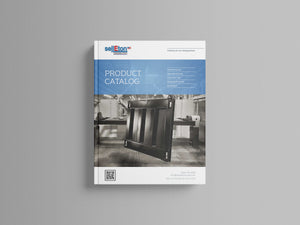
Top Quality Load Cells for Weighing Systems & Applications
Load cells for weighing are sensors that measure weight by converting force into an electrical signal. They are vital in industries for applications like truck scales and lab balances. This article covers the types of load cells, their components, and how they are used.
Key Takeaways
-
Load cells are crucial force transducers that convert mechanical force into electrical signals for accurate weight measurement, with various types like shear beam, S-type, and single point load cells catering to specific industrial needs.
-
Stainless steel load cells offer enhanced durability and accuracy, particularly in harsh environments, making them ideal for applications exposed to chemicals and extreme temperatures.
-
Regular maintenance and calibration of load cells using precise techniques like deadweight calibration are essential to ensure their long-term reliability and accuracy in industrial weighing systems.
Understanding Load Cells for Weighing
At their core, load cells are force transducers that convert force into an electrical signal, allowing for accurate weight measurement. This transformation is achieved through strain gauges, which measure changes in electrical resistance as force is applied. When a load is placed on the weighing platform, the resulting deformation alters the resistance in the strain gauges, generating a corresponding electrical signal that quantifies the weight.
Shear beam load cells are among the most commonly used types in industrial applications. These load cells are designed to handle heavy loads with high precision, making them ideal for truck scales and floor scales. Other types, such as S-type load cells and beam load cells, offer versatility and accuracy for a wide range of weighing systems.
Understanding the fundamental operation of load cells is the first step in appreciating their critical role in modern industrial processes.
Types of Load Cells Used in Industrial Weighing
Load cells come in various types, each suited to specific industrial applications. Strain gauge load cells are the most prevalent due to their high accuracy and reliability, with accuracy ranging from 0.03% to 0.25% of full scale. These load cells are versatile and can be found in applications ranging from small bench scales to large truck scales.
Beam load cells, including bending beam, single-ended shear beam, and double-ended shear beam types, are commonly utilized in tank and floor scales. Shear beam load cells, in particular, are favored for their ability to handle significant loads with minimal deflection, ensuring precise measurements. Single point load cells are ideal for compact scales and offer high accuracy regardless of the load’s position on the platform.
In environments where safety and cleanliness are priorities, hydraulic and pneumatic load cells are excellent alternatives. Hydraulic load cells use fluid pressure to convey load measurements, read through a pressure gauge. Pneumatic load cells, on the other hand, measure force by balancing it with pressurized gas, making them suitable for accurately weighing light loads.
Capacitive load cells operate by measuring the change in capacitance between plates when a load is applied. These load cells are less common but offer unique advantages in specific applications. Understanding the diversity of load cells helps in selecting the right type for your industrial weighing needs.
Key Components of Load Cell Scales
The effectiveness of load cell scales hinges on several key components. The loading platform is crucial as it applies the force necessary for the load cell to function accurately. A well-designed platform ensures that the load is evenly distributed, minimizing the potential for measurement errors.
At the heart of load cell design is the Wheatstone bridge circuit. This configuration allows for precise measurements by detecting changes in resistance caused by strain. Utilizing multiple strain gauges in a Wheatstone bridge setup enhances the load cell’s accuracy, compensating for off-axis loads and ensuring reliable readings.
Load cells featuring metal foil strain gauges are particularly favored for their durability, cost-effectiveness, and high measurement accuracy. These components work in harmony to deliver the precision required in industrial weighing systems, making load cell scales indispensable tools in various applications.
Enhancing Precision with Load Cells
Precision in weighing systems is non-negotiable, and load cells play a pivotal role in achieving this accuracy. Strain gauges, the core components of many load cells, convert mechanical deformation into electrical signals, providing a measure of the applied load. This conversion process is critical for accurate force measurement and is a hallmark of high-quality load cells.
Piezoelectric load cells offer another layer of precision, generating an electrical signal in response to stress applied. These load cells are particularly suitable for dynamic force measurements, ensuring high accuracy in applications where forces fluctuate rapidly. In industries where precision is paramount, such as pharmaceuticals, load cells must meet stringent certification standards to confirm their reliability and accuracy.
Using load cells made from stainless steel further enhances their precision and reliability, especially in harsh conditions. Stainless steel load cells are resistant to corrosion and environmental factors, ensuring consistent performance even in challenging environments. By incorporating these advanced technologies and materials, weighing systems can achieve unparalleled accuracy and stability.
Applications of Load Cells in Industrial Weighing Systems
Load cells are integral to modern electronic scales, providing precise measurements across numerous industries. Canister load cells, for instance, are best suited for heavy-duty applications and are often found in truck and railroad scales. These robust load cells ensure accurate weight measurement even under the most demanding conditions.
S-type load cells are versatile and can be used in both tension and compression applications, making them common in hanging scales. Tension link load cells, on the other hand, are designed for measuring inline tension forces and are frequently utilized in crane scales.
Beam load cells are commonly employed in floor scales, capable of handling capacities from a few kilograms to several tons. Single point load cells are ideal for compact scales, ensuring accurate measurements without sacrificing economical construction. For bulk material measurement, canister load cells are predominantly used in tank and silo weighing applications. The diverse applications of load cells highlight their versatility and indispensability in industrial weighing systems.
Selecting the Right Load Cell by Capacity
Selecting the appropriate load cell by capacity is crucial for ensuring accurate measurements in various industrial applications. It is advisable for the capacity of a load cell to exceed the expected maximum load by 25-30% to accommodate any additional forces. This precaution helps prevent damage and ensures the longevity of the load cell.
The nature of the object being weighed, including its dimensions and whether it is static or dynamic, influences the required capacity of the load cell. For low-capacity applications, single-point load cells are ideal as they allow for accurate measurements regardless of the load’s position on the scale platform.
In scenarios where there is a risk of impact or overload, selecting a load cell with a higher capacity can help maintain accuracy and prevent potential damage. Understanding these factors is essential for choosing the right load cell, ensuring reliable and precise weight measurements in all industrial applications.
The Role of Stainless Steel in Load Cells
Stainless steel load cells are renowned for their durability and resistance to harsh environmental conditions. In corrosive environments, stainless steel is preferred as it is less prone to rust compared to aluminum. This resistance makes stainless steel load cells ideal for applications involving exposure to chemicals and extreme temperatures.
The application of a silicone epoxy coating further enhances the protection of stainless steel load cells against moisture and chemicals. These load cells are often hermetically sealed to protect the internal electronics from hazardous environments, ensuring reliable performance and longevity.
Using stainless steel in load cells not only enhances their durability but also contributes to their accuracy and reliability in challenging conditions. This makes them an excellent choice for a wide range of industrial weighing systems.
Maintenance and Calibration of Load Cells
Regular maintenance and calibration of load cells are essential to maintain their accuracy and performance. Deadweight calibration, where known weights are applied to verify the load cell’s output, is the most precise method. This method ensures that the load cell provides accurate measurements, crucial for industrial applications.
Zero balance calibration, which ensures that a load cell reads zero without any load applied, is another important aspect of maintaining accuracy. Documenting the calibration process is essential for traceability and maintaining measurement standards. Using high-quality calibration equipment helps avoid introducing errors during the process, ensuring the reliability of the load cell.
Regular maintenance and calibration schedules help businesses ensure the long-term accuracy and reliability of their load cells, which is vital for precision in industrial weighing systems. Technicians play a crucial role in this process.
Interlinking Selleton Scales Products
Selleton Scales offers a wide range of load cell scales designed to meet various industrial needs. For heavy-duty applications, their truck scales provide reliable and accurate weight measurements, ensuring efficient loading and unloading operations. These scales are equipped with high-capacity load cells that can handle substantial loads without compromising accuracy.
For more versatile applications, Selleton Scales’ floor scales are an excellent choice. These scales employ beam load cells, capable of handling a wide range of capacities from a few kilograms to several tons. Their detailed product descriptions and specifications help customers make informed purchasing decisions, ensuring they set the right scale for their needs.
Additionally, Selleton Scales’ comprehensive catalog includes various types and capacities of load cells suitable for different weighing systems and items. Customers can access product pages with customer reviews, enhancing trust and transparency. By interlinking these products, businesses can easily find the right solutions for their industrial weighing applications.
Summary
In conclusion, load cells are indispensable in industrial weighing systems, providing the precision and reliability needed for accurate weight measurements. From understanding their basic operation to selecting the right type and capacity, this guide has covered all the essential aspects of load cells. By incorporating advanced technologies and materials, such as stainless steel, load cells ensure optimal performance even in challenging environments. Regular maintenance and calibration further enhance their accuracy, making them a vital component in various industrial applications.
Frequently Asked Questions
What is a load cell and how does it work?
A load cell is a transducer that converts force into an electrical signal, enabling accurate weight measurement. It functions by utilizing strain gauges, which detect changes in electrical resistance when force is applied.
What types of load cells are commonly used in industrial weighing?
Strain gauge load cells, beam load cells, S-type load cells, hydraulic load cells, and pneumatic load cells are commonly used in industrial weighing applications. Each type serves specific needs, such as truck scales and floor scales.
Why is stainless steel used in load cells?
Stainless steel is employed in load cells due to its durability and resistance to corrosion and extreme temperatures, ensuring reliable performance and longevity in various industrial applications.
How do I select the right load cell for my application?
To select the right load cell for your application, ensure it has a capacity that exceeds your expected maximum load by 25-30% and consider the nature of the object being weighed as well as whether the application involves static or dynamic loads. This approach will help ensure optimal performance and reliability.
Why is calibration important for load cells?
Calibration is essential for load cells as it guarantees their accuracy and reliability, which are vital for precise measurements in industrial applications. Regularly calibrating load cells using methods like deadweight calibration ensures optimal performance and trustworthy results.

